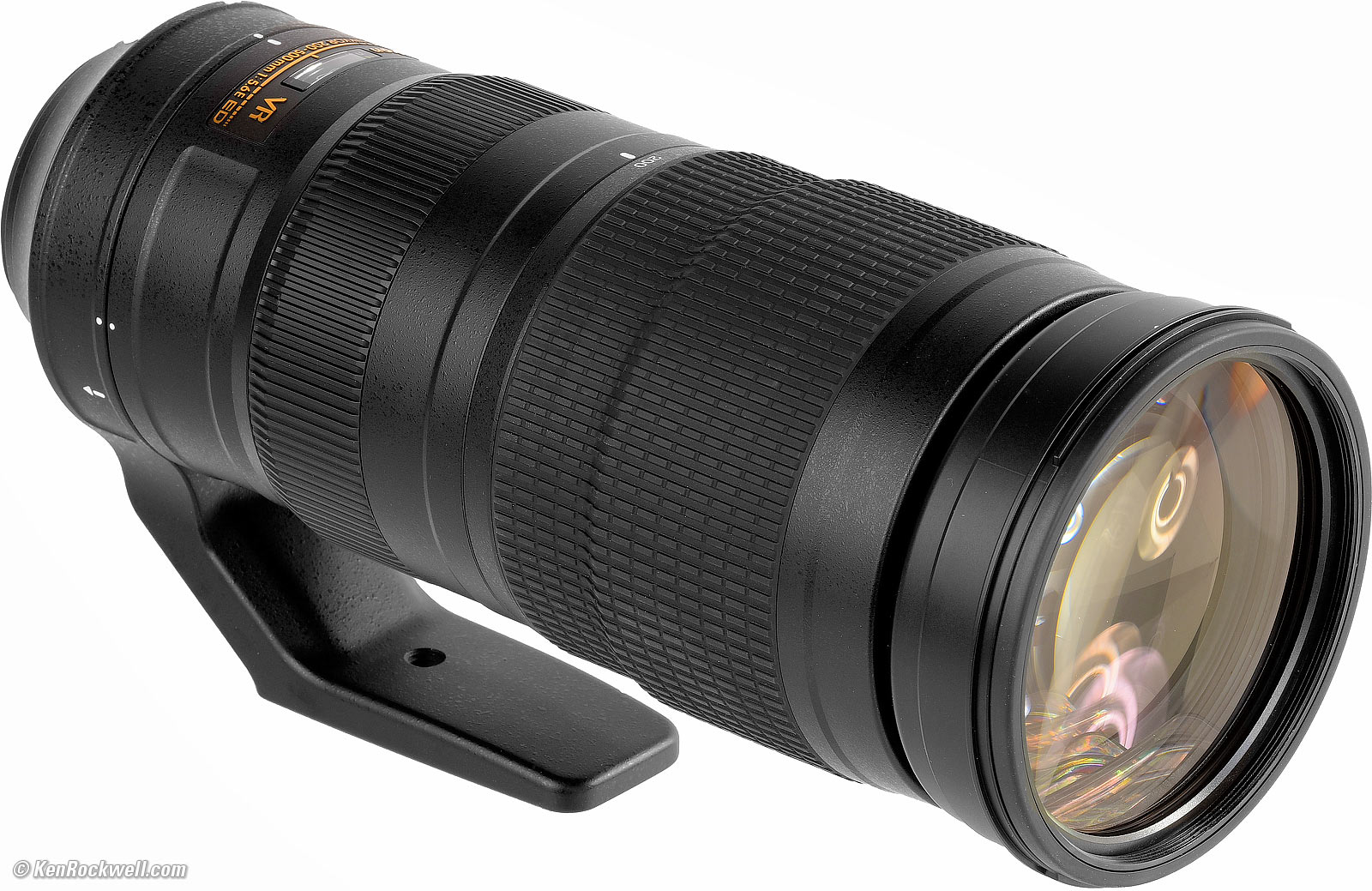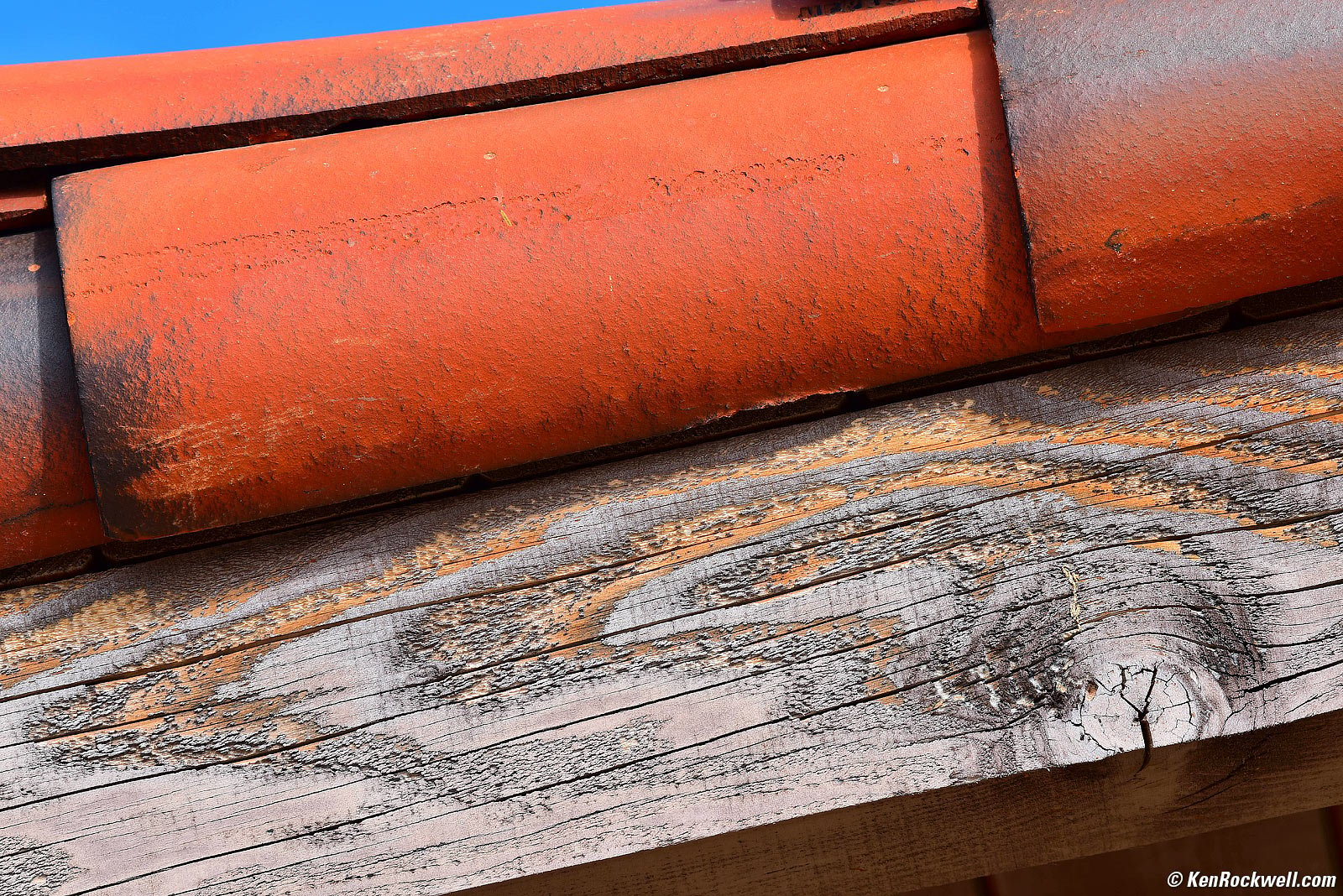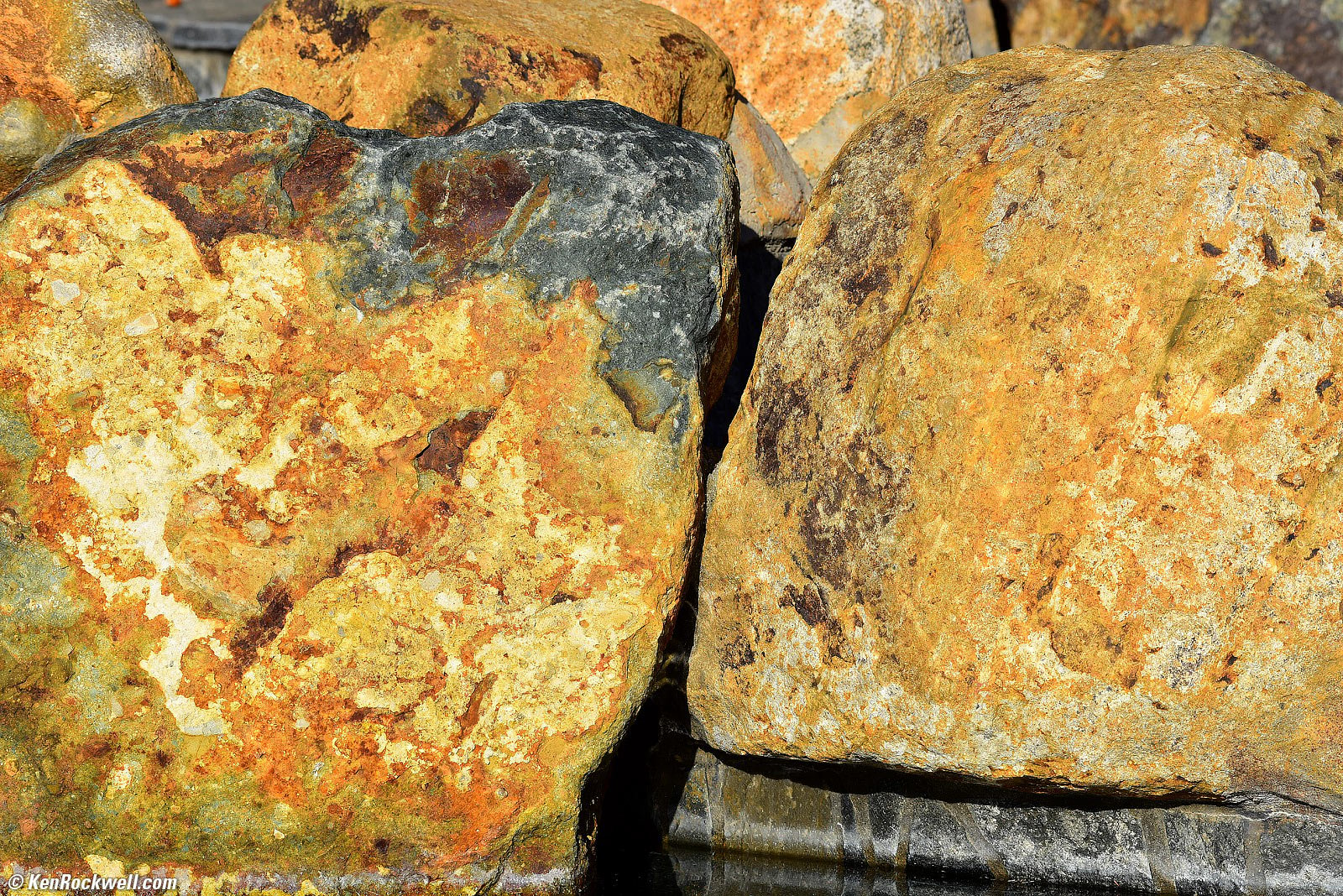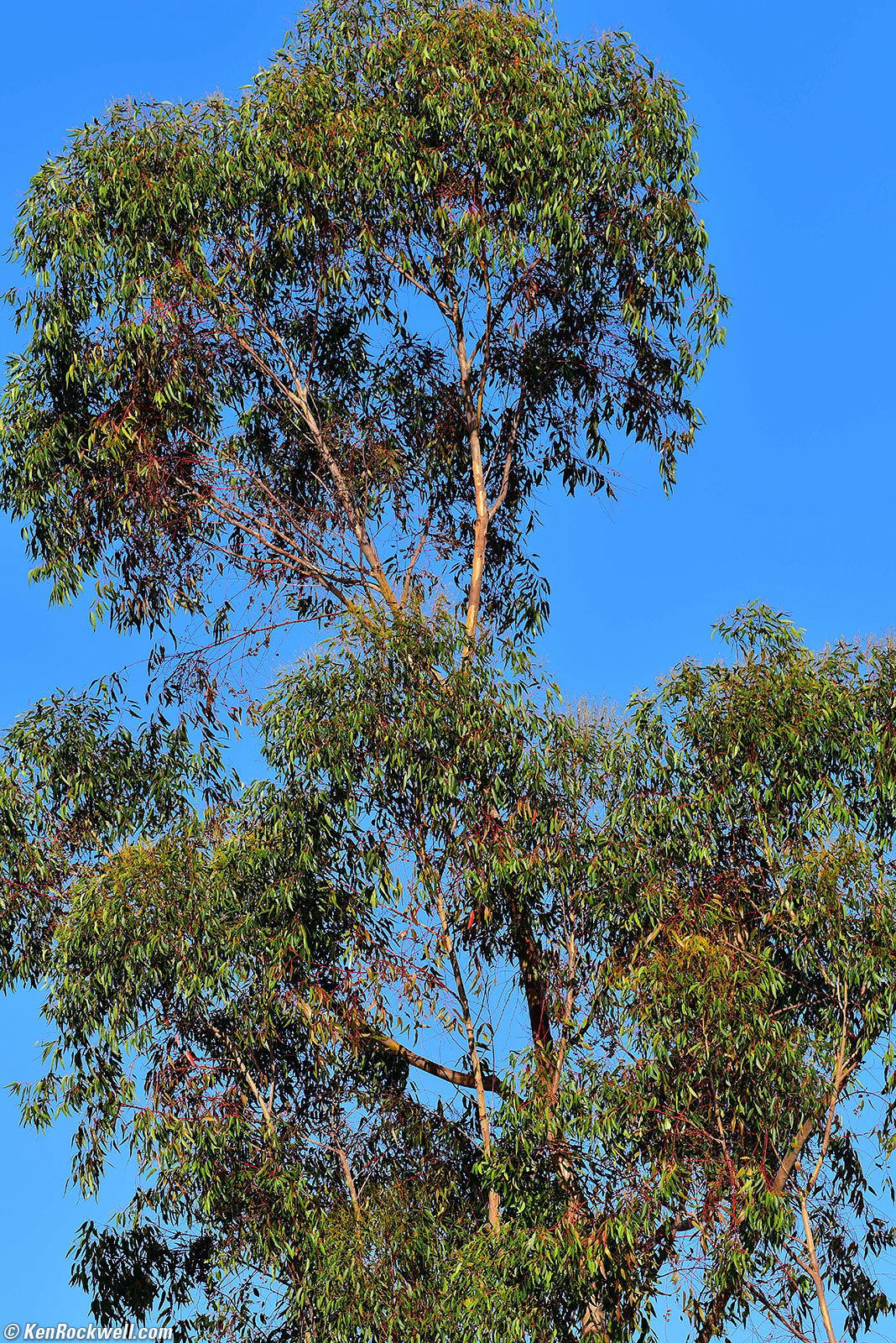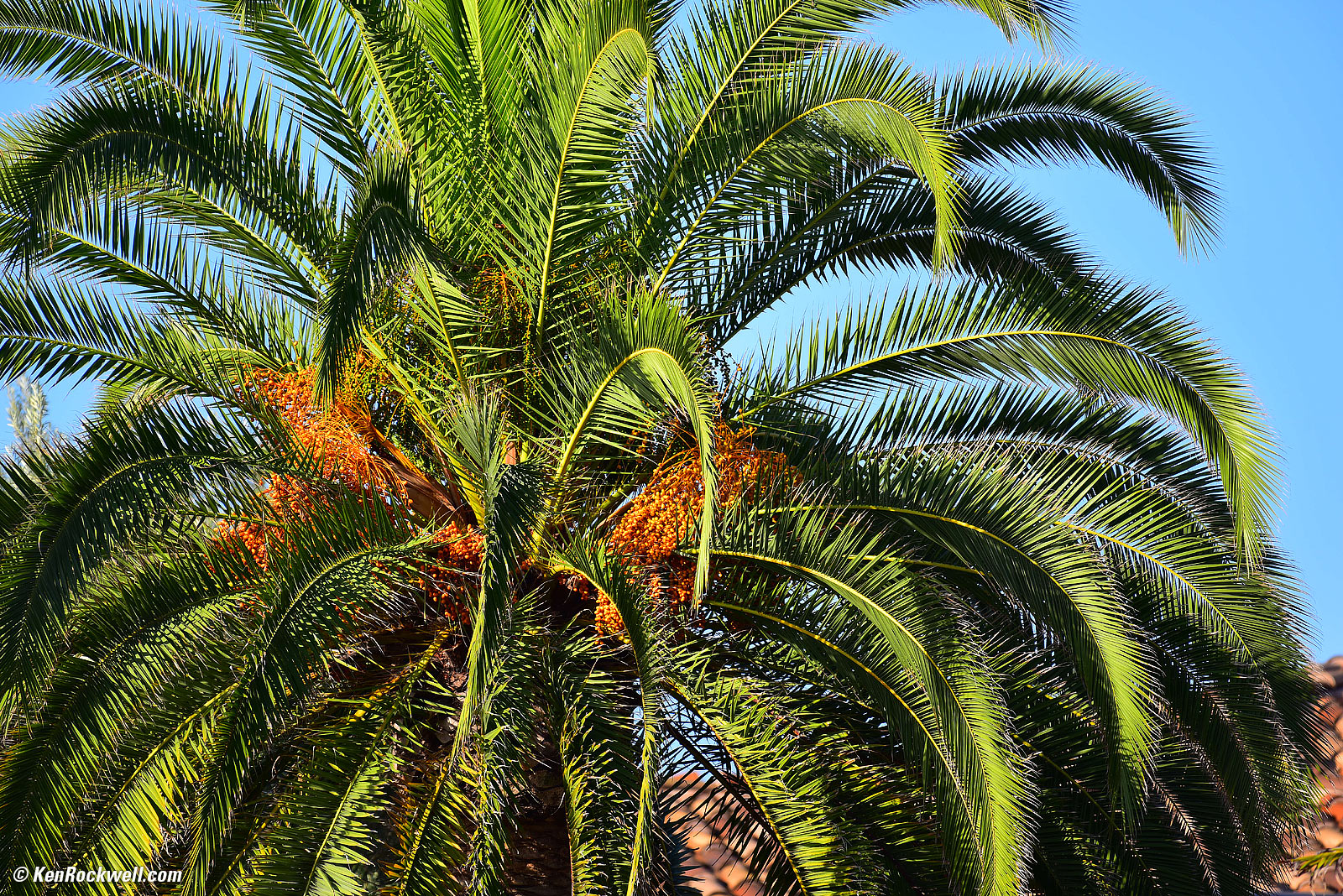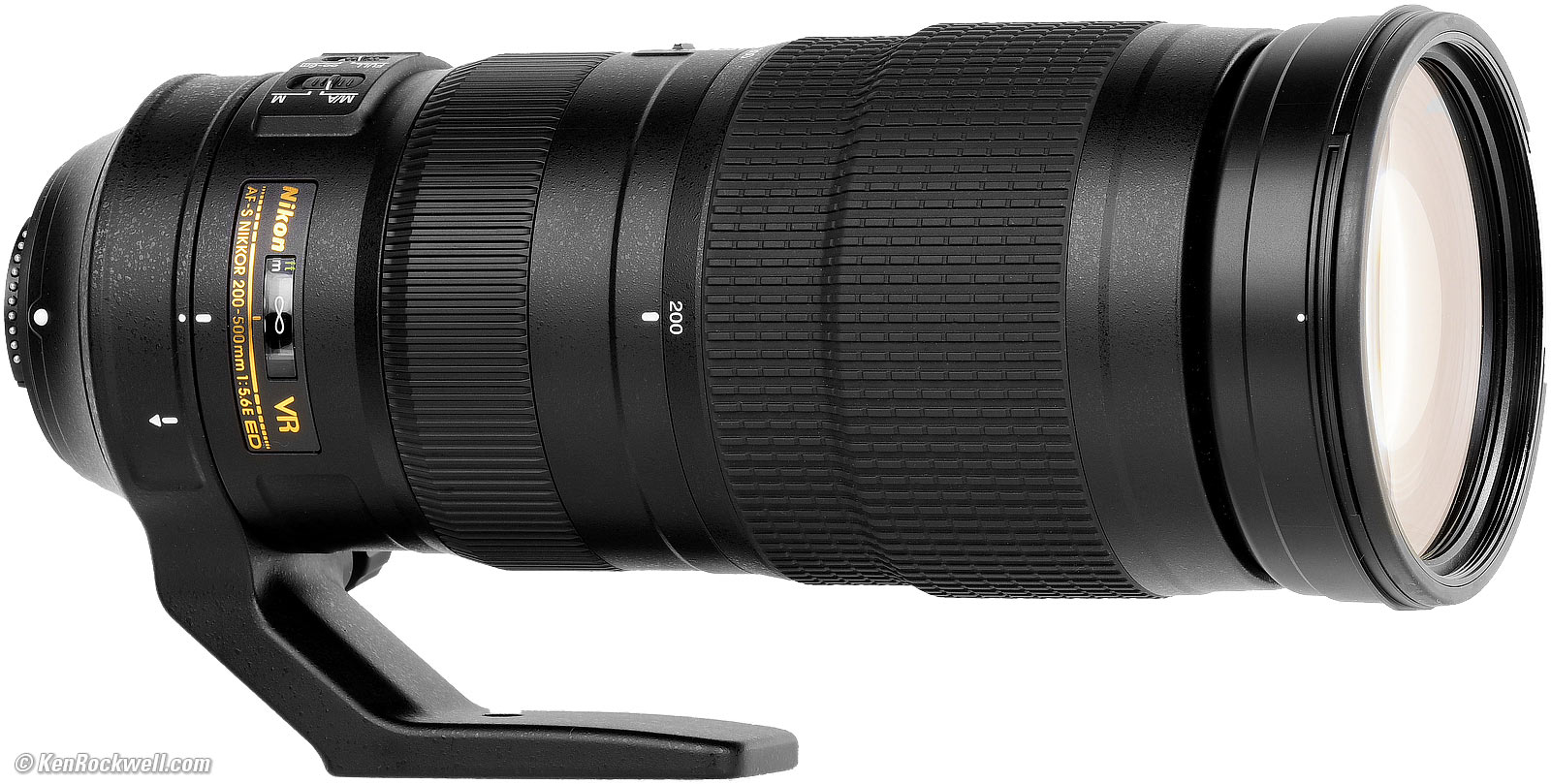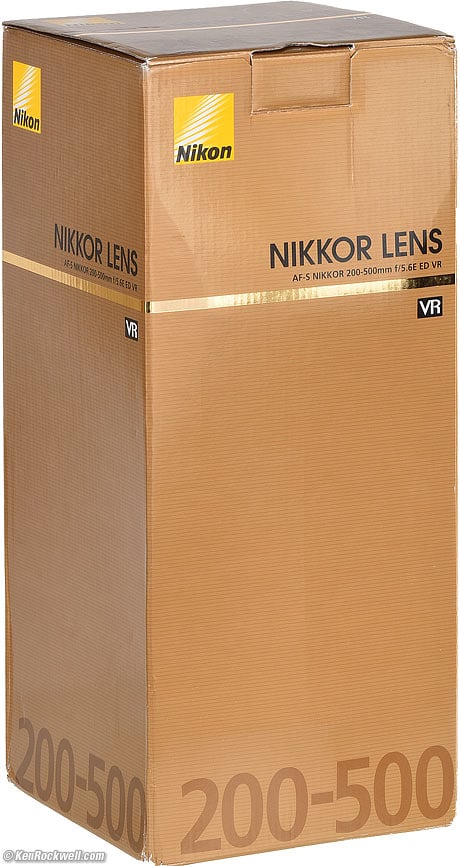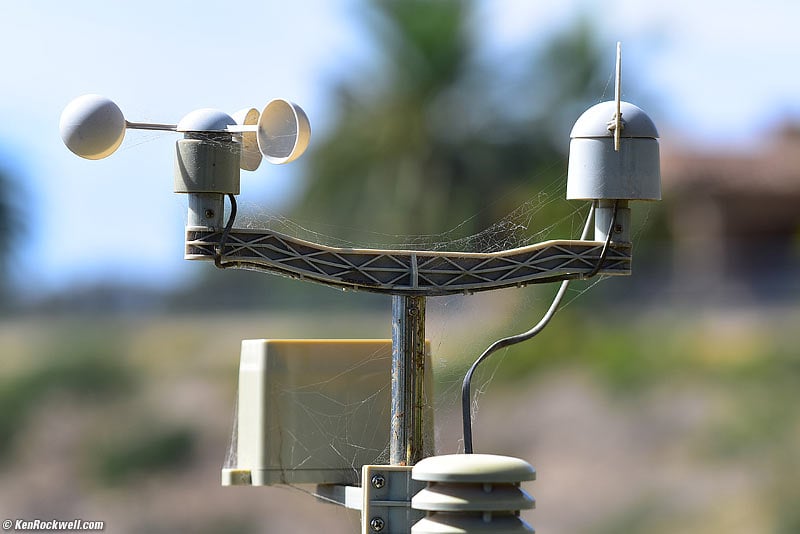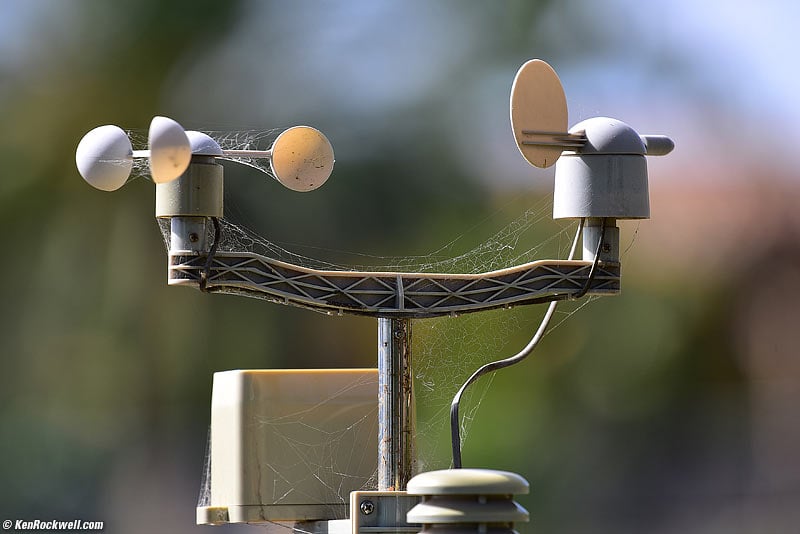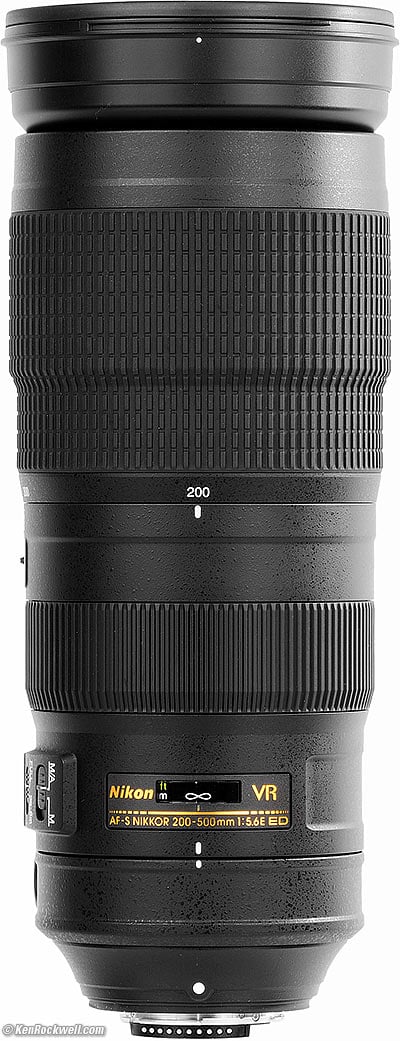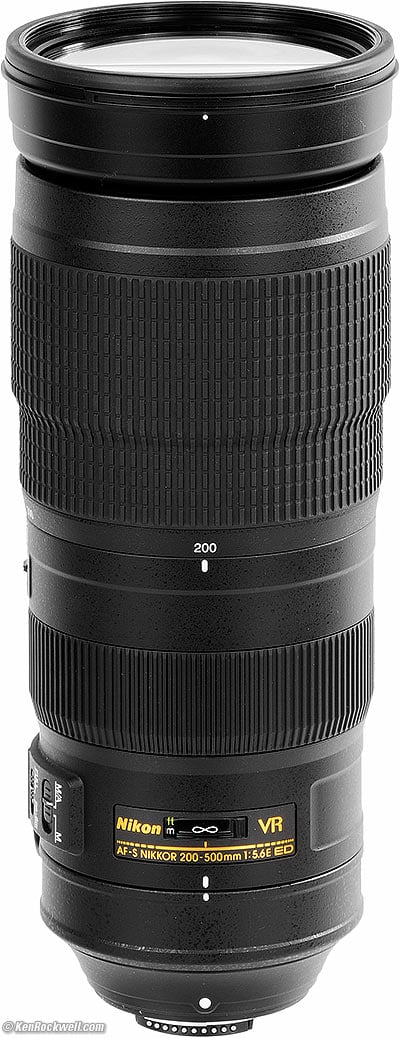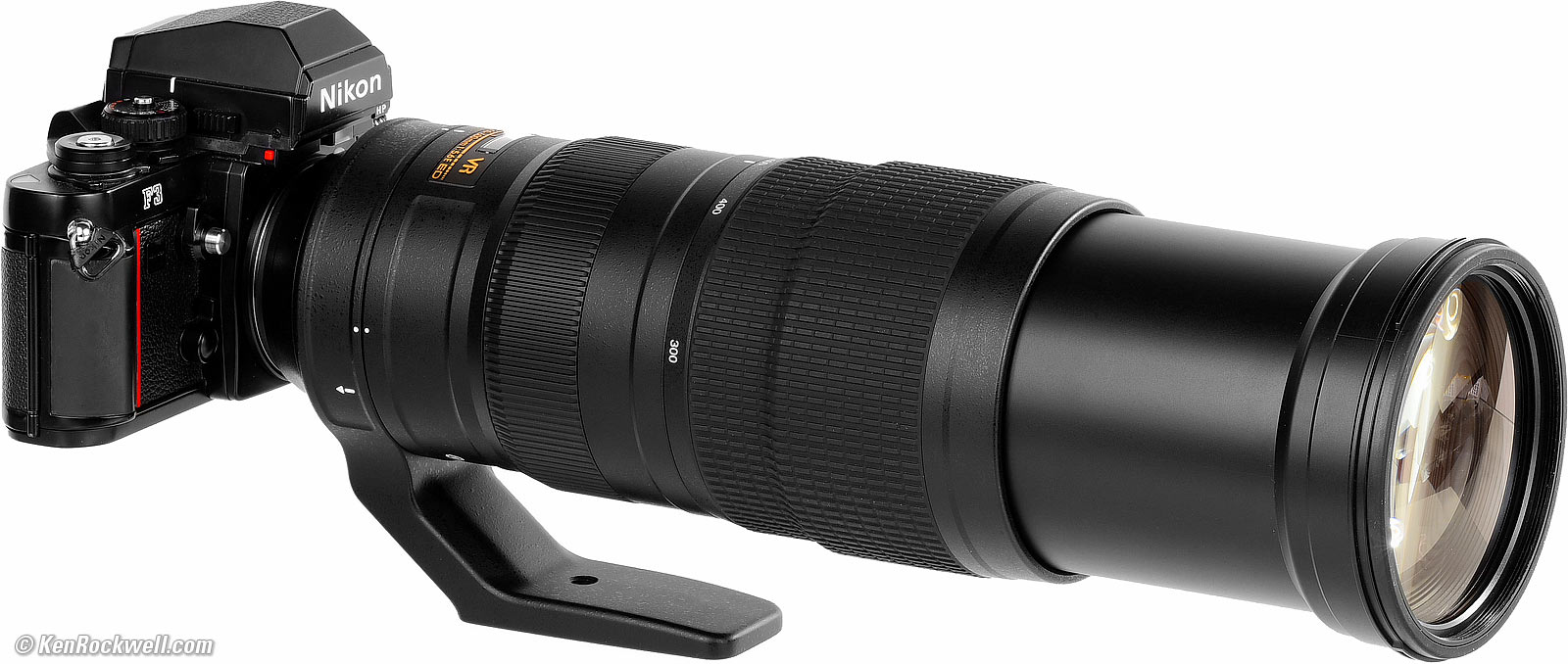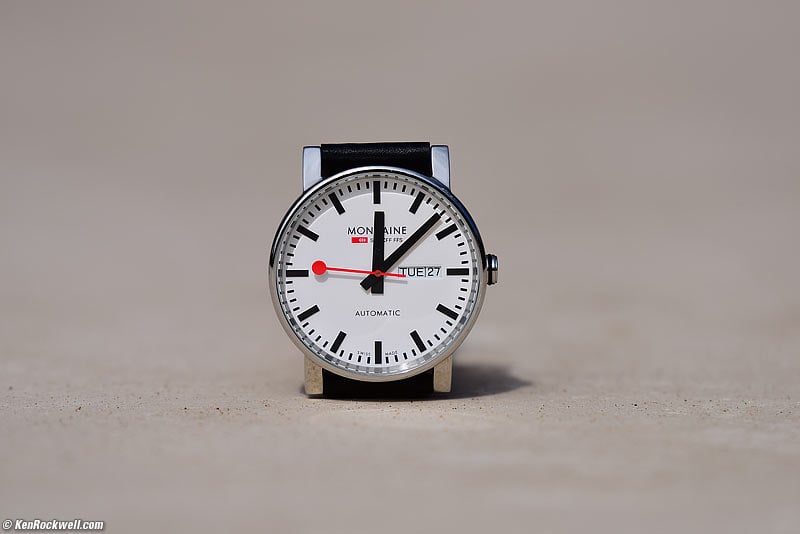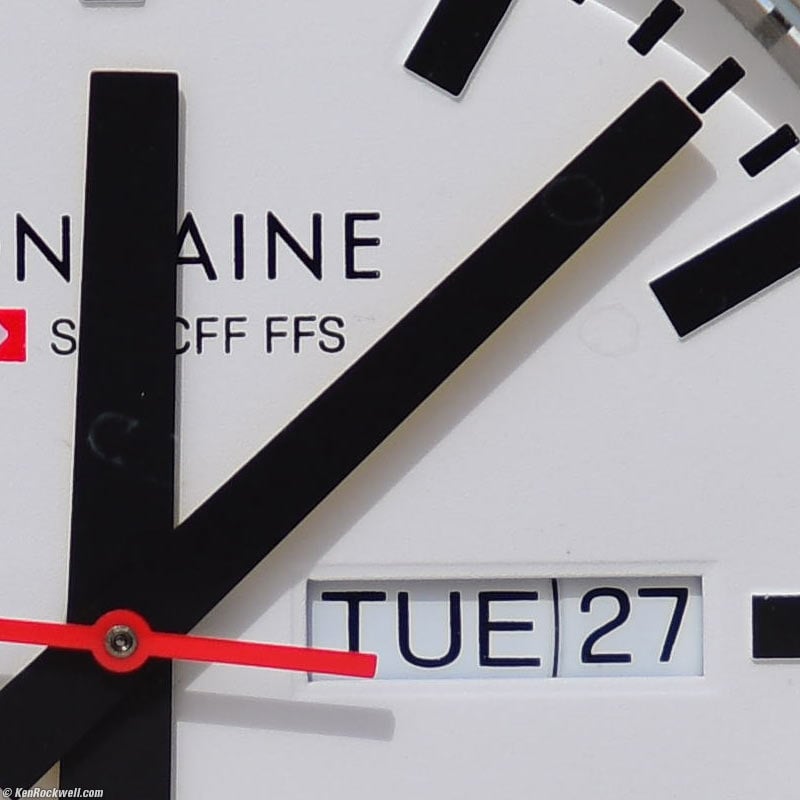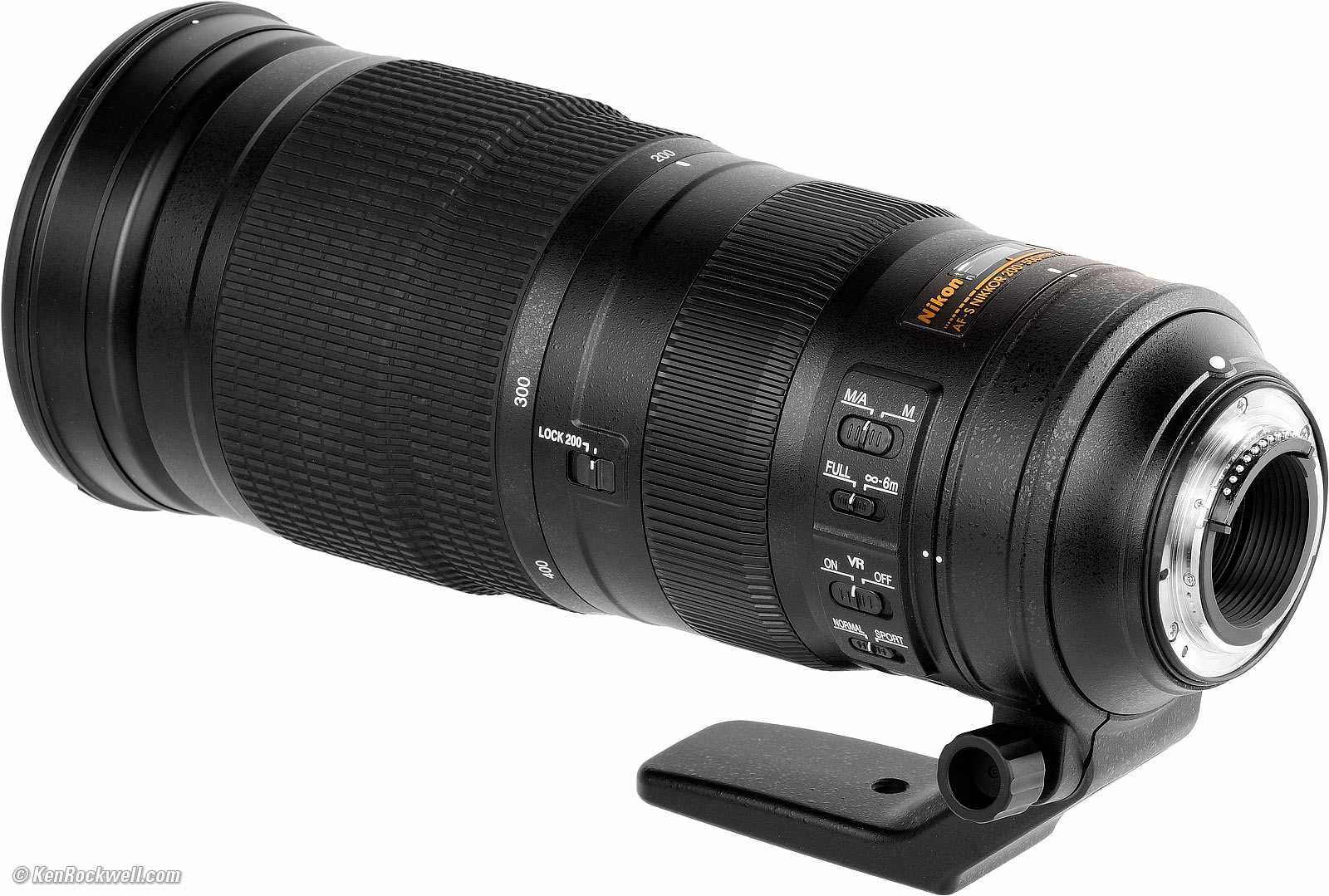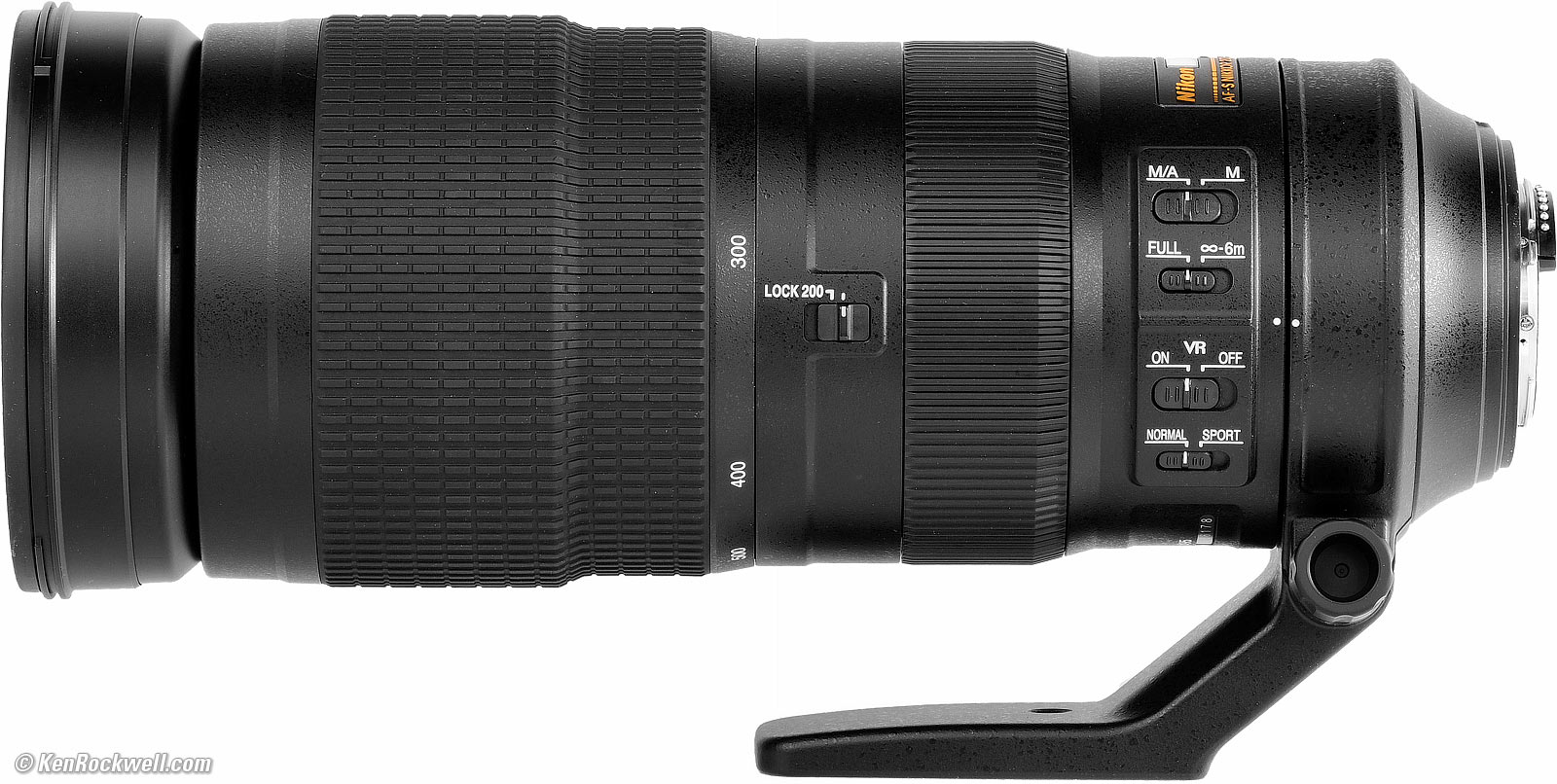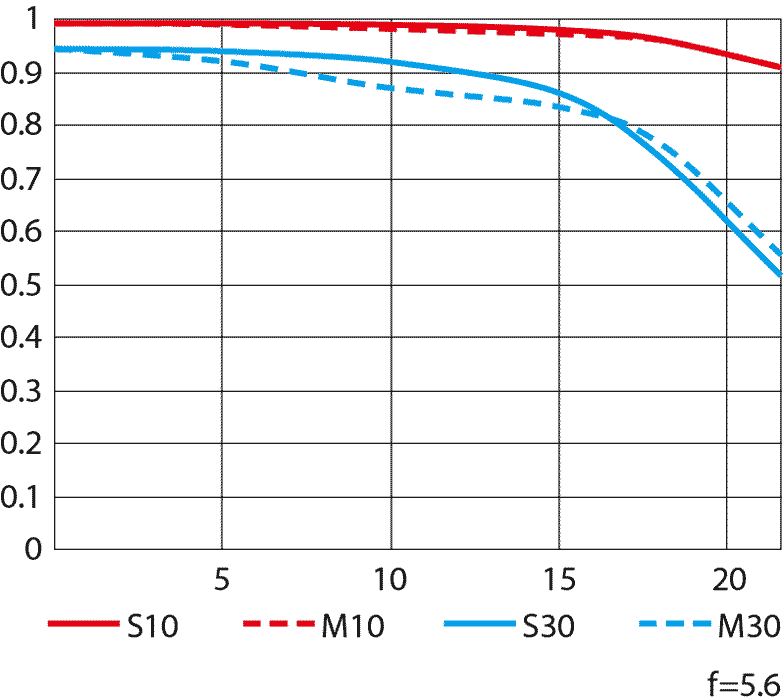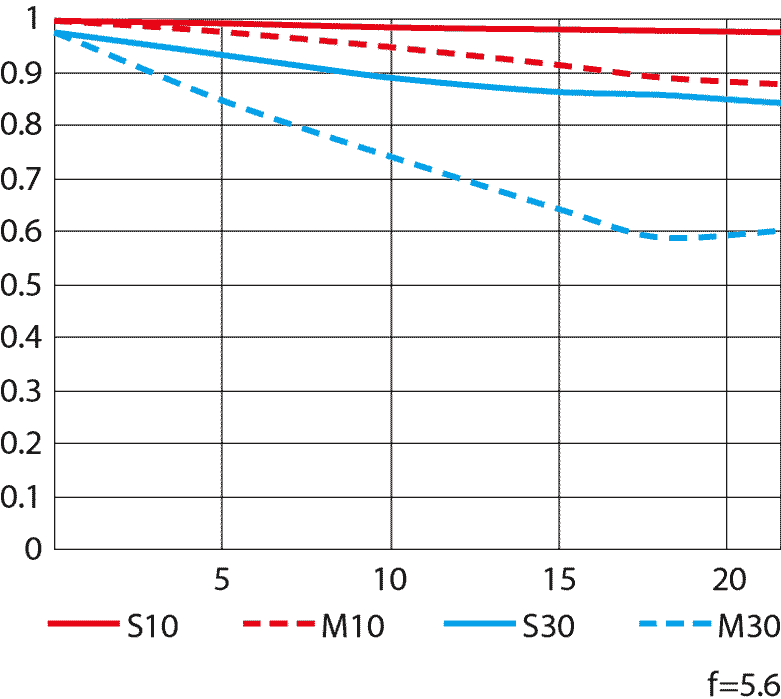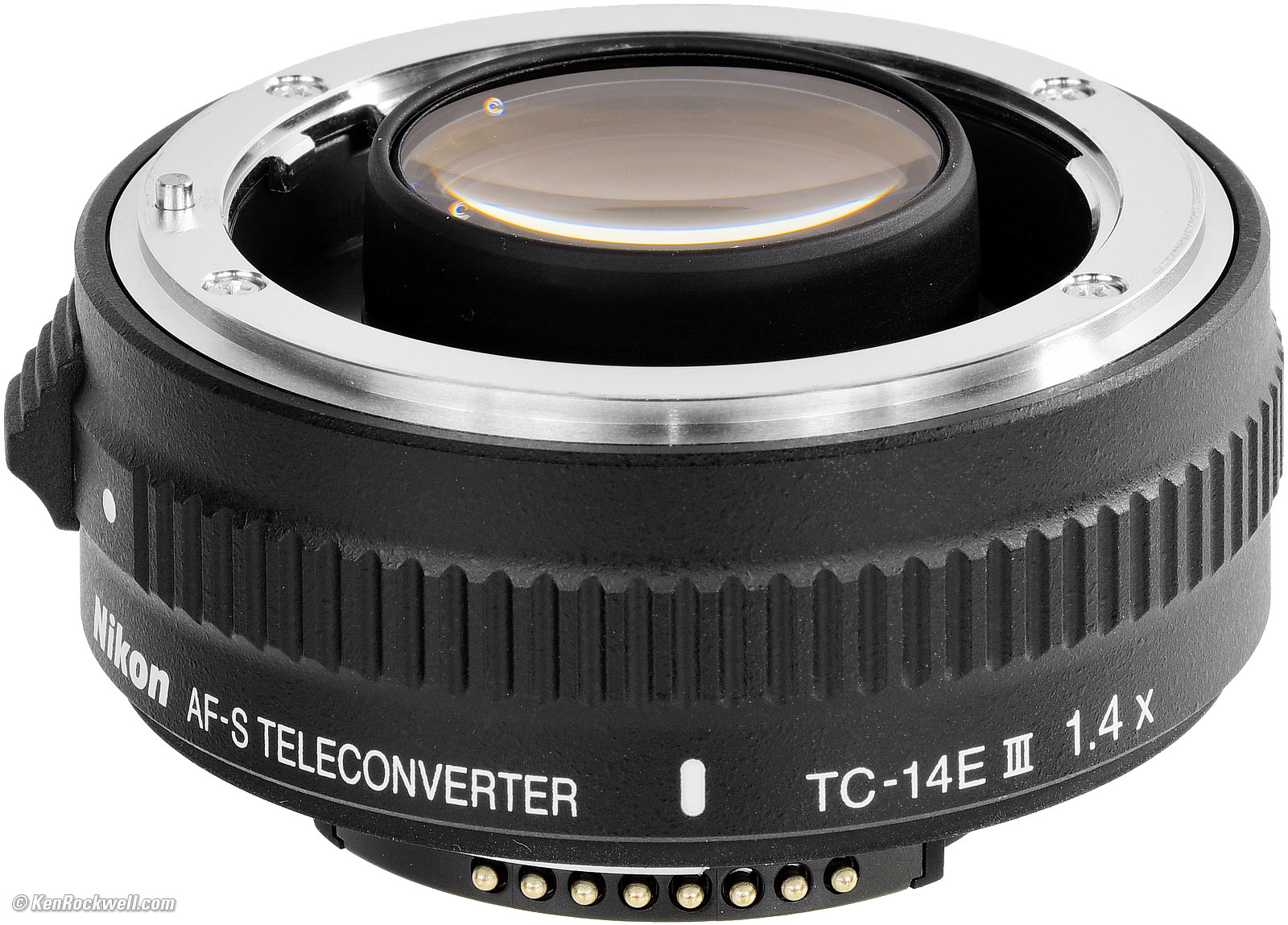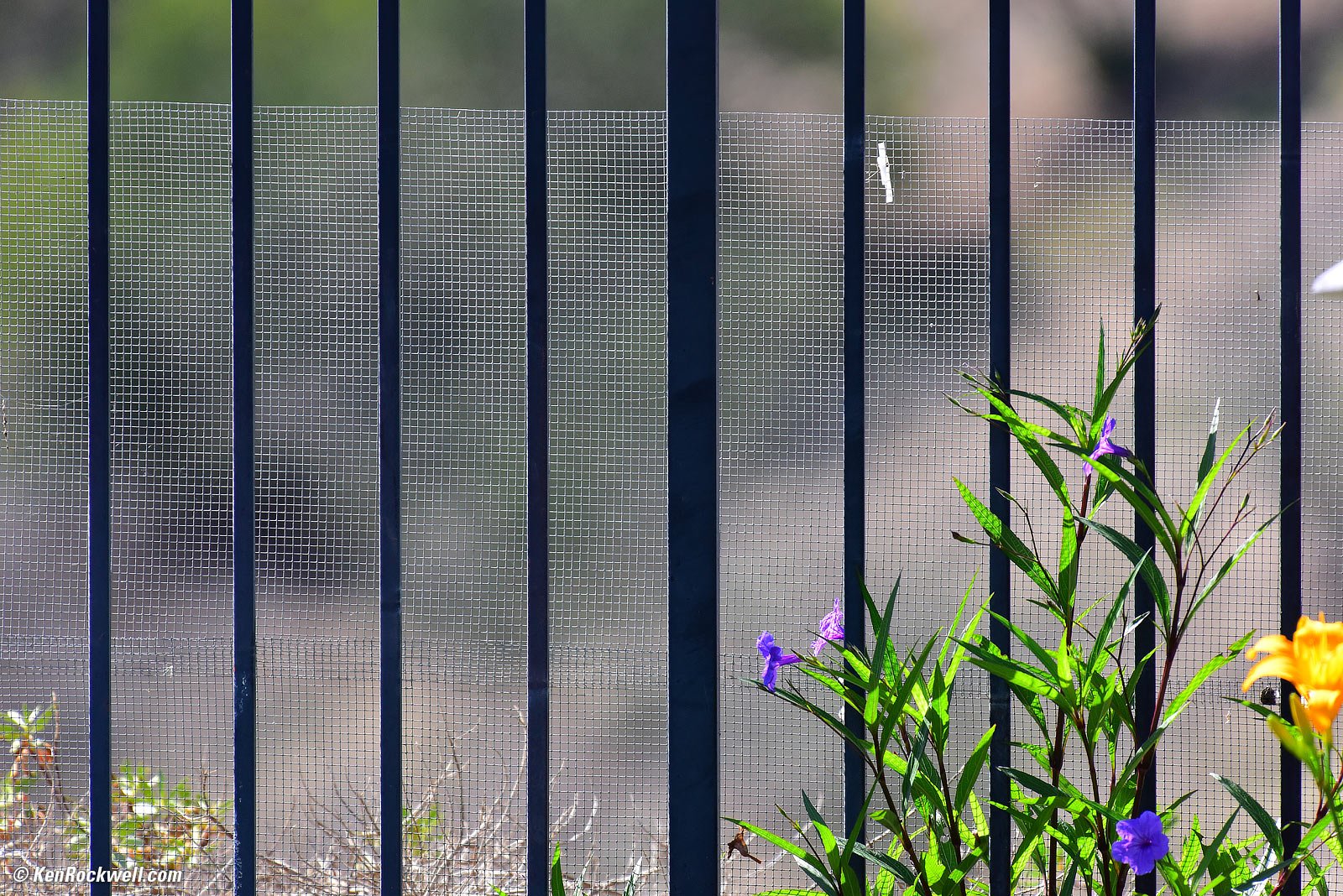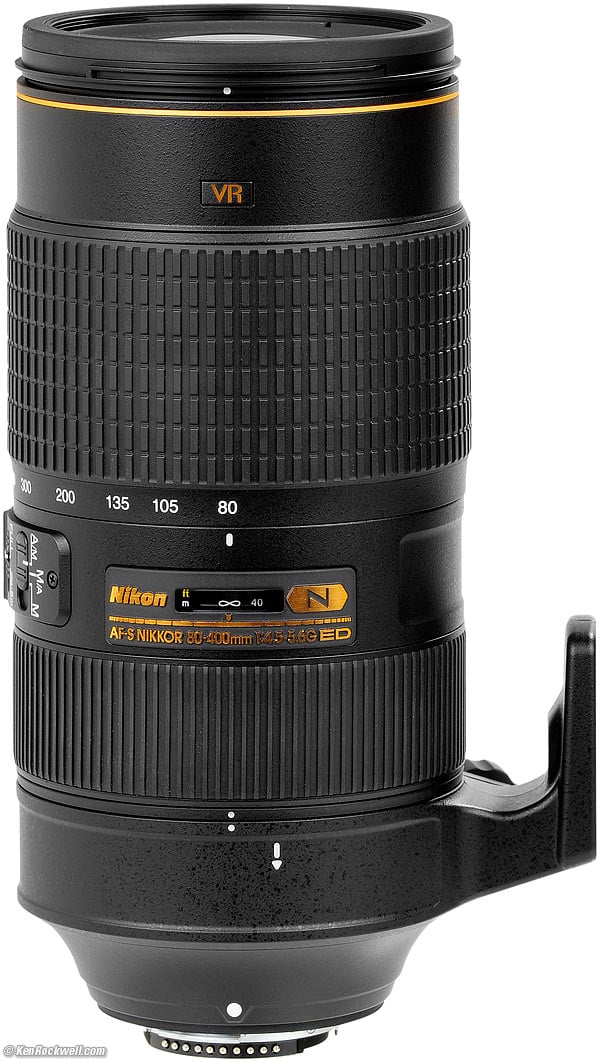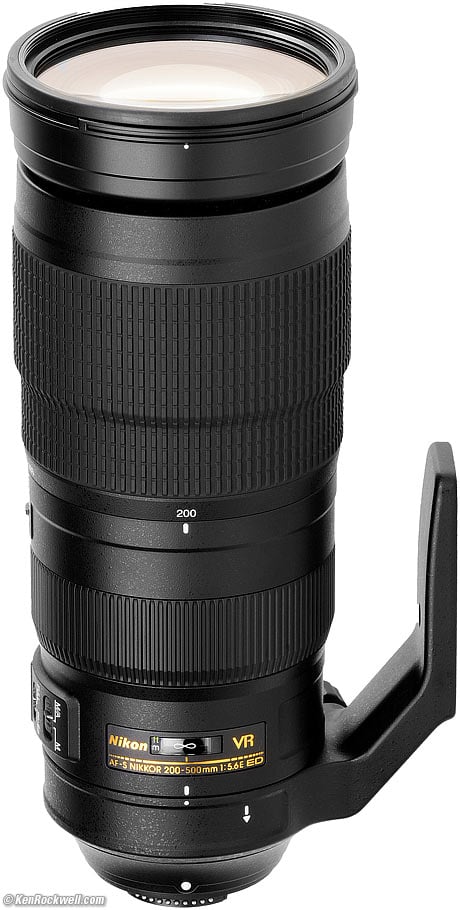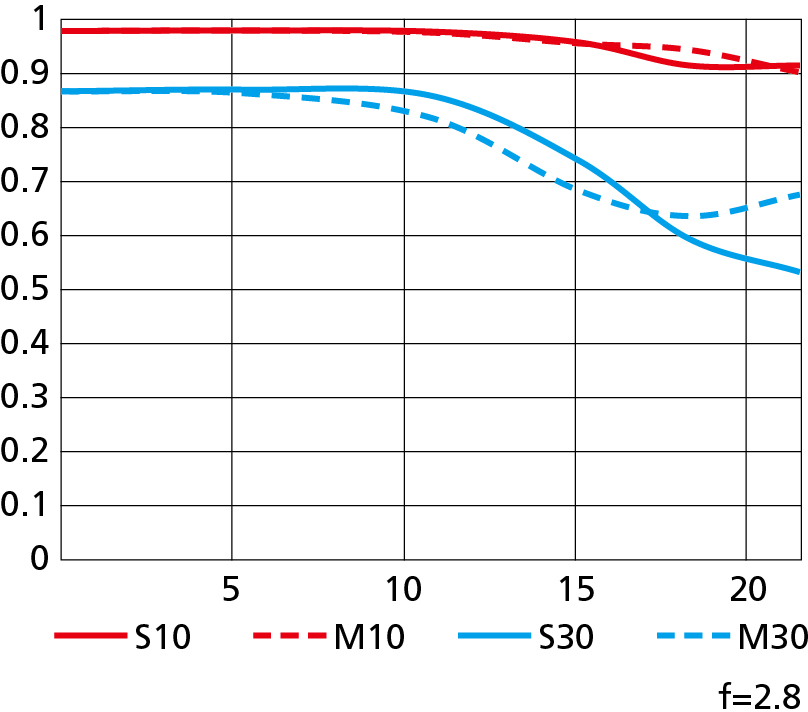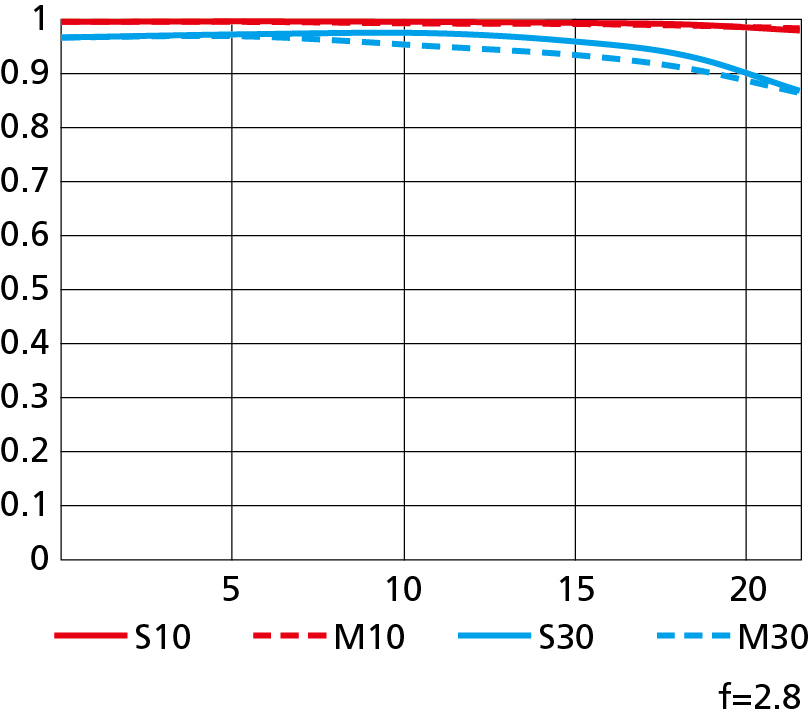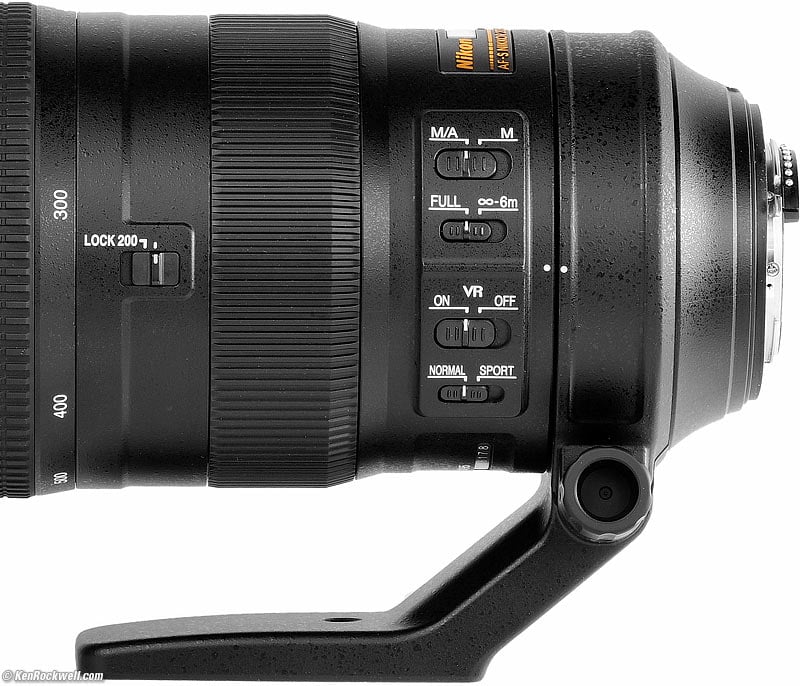Nikon 200-500mm VR
FX f/5.6 E ED VR (2015-)
Sample Images Intro Compatibility Specifications
Performance Compared Usage Recommendations More
Nikon AF-S NIKKOR 200-500mm f/5.6E ED VR (FX and DX coverage, 95mm filters, 81¼ oz./2,300g with collar, 73¾ oz./2,090g without collar, 7.2'/2.2 m close focus, $1,397 new or about $775 used at eBay if you know How to Win at eBay). bigger. I got mine at Adorama; I'd just as well get it at B&H, at Crutchfield, at Amazon or used at eBay.
This all-content, junk-free website's biggest source of support is when you use those or any of these links to approved sources when you get anything, regardless of the country in which you live. Nikon does not seal its boxes, so never buy at retail or any source not on my personally approved list since you'll have no way of knowing if you're missing accessories, getting a defective, dropped, damaged or used product, a customer return or if the warranty has already been registered to someone else online! The approved sources I use ship from secure, remote automated warehouses where salespeople or other customers never, ever get to touch your lens before you do, and they have the best prices, selection, service and return policies.
August 2023 Nikon Reviews Nikon Lenses All Reviews
NEW: 500mm f/5.6 PF (2018-, $3,597)
200-400mm f/4 VR II (2010-, $7,000)
80-400mm VR II AF-S (2013-, $2,700)
80-400mm VR AF-D (2000-2013, $700 used)
Canon 100-400mm f/4 L IS II (2014-, $2,200)
Tokina 150-500mm f/5.6 (manual focus,1986-2000, about $250 used)
Sample Images
Top Sample Images Intro Compatibility Specifications
Performance Compared Usage Recommendations More
Wood and Tile, 27 October 2015. Nikon D810, Nikon 200-500mm VR at 360mm, f/11 at 1/125 hand-held at Auto ISO 100. bigger or full-resolution 36MP file to explore on your computer (most portable devices can't show all the pixels in the full resolution file).
Stone, 29 October 2015. Nikon D810, Nikon 200-500mm VR at 320mm, f8 at 1/250 hand-held at Auto ISO 100. bigger or camera-original 36MP file to explore on your computer (most portable devices can't show all the pixels in the full resolution file).
If you can get everything in focus, which requires a flat subject (not these rocks), it's usually sharp edge-to-edge.
Eucalyptus, 29 October 2015. Nikon D810, Nikon 200-500mm VR at 200mm, wide-open at f/5.6 at 1/500 hand-held at Auto ISO 100. bigger or camera-original 36MP file to explore on your computer (most portable devices can't show all the pixels in the full resolution file).
It's sharp edge-to-edge even wide-open at 200mm, and there's no falloff, either.
Palm, 29 October 2015. Nikon D810, Nikon 200-500mm VR at 500mm, wide-open at f/5.6 at 1/250 hand-held at Auto ISO 100. bigger or camera-original 36MP file to explore on your computer (most portable devices can't show all the pixels in the full resolution file).
It's difficult to get things in focus both in the center and at the sides at 500mm, but if you do, it's sharp even wide-open from edge-to-edge — and there's no falloff.
Introduction
Top Sample Images Intro Compatibility Specifications
Performance Compared Usage Recommendations More
|
Adorama pays top dollar for your used gear. I buy only from these approved sources. I can't vouch for ads below. |
This inexpensive Nikon 200-500 has excellent optics and superb vibration reduction (VR). It's the best buy in Nikon ultratelephotos ever. It's easy to read a "HIGH VOLTAGE" sticker on a power pole a mile away at 500mm handheld on a 36MP D810.
VR is rated at 4½ stops improvement, and in actual practice, I usually get perfect results hand-held at 1/15 at 500mm! You can leave your tripod at home with this ultra-tele.
This 200-500mm has no light falloff; shoot it wide-open and the corners don't go dark.
This new 200-500mm is Nikon's first reasonably priced ultratelephoto ever. Birders and other ultratele users are breaking out the Champagne! Unlike the overpriced 80-400mm VR ($2,700 for just about the same thing), this new lens is a complete winner.
It's made as well as the $2,700 80-400mm VR. What you loose for paying only half as much is that this 200-500 doesn't focus as close or as fast as the 80-400mm — but the 200-500 goes to 500mm at a generous f/5.6 and the rear half of its zoom ring is metal!
This lens is for long-distance use; it doesn't focus very close (7.2' or 2.2m minimum) and it is slow (only f/5.6 at every aperture) and it doesn't zoom wide (200mm minimum), and with these limitations allows it to be sold at a very low price. You can pay the same price for junk-brand lenses like the Tamron 150-600mm.
Even nicer is that Nikon throws in the tripod collar, which is an extra-cost option with the $2,000 300mm f/4 PF. The hood and case are also included, whoo hoo!
New is a SPORT VR mode, which claims to allow VR to work well while photographing things that move unpredictably.
Grab the focus ring at any time for instant manual focus override.
I got my 200-500 at Adorama. I'd also get it at B&H, at Crutchfield, at Amazon or used at eBay if you know How to Win at eBay.
Compatibility
Top Sample Images Intro Compatibility Specifications
Performance Compared Usage Recommendations More
It works teleconverters; see the performance section for details.
Use the FTZ or FTZ II adapter and everything should work great on Nikon's Z-series mirrorless cameras.
This is a full-frame lens optimized for use on FX DSLR cameras, and I'll be reviewing it as such.
It works great on DX cameras, for which you may make the usual inferences.
If you want to shot at other than f/5.6, the "E" electronic diaphragm only works on cameras introduced since 2007. These cameras are the D4, D4s, D3, D3s, D3P, D3x, Df, D810, D800/e, D750, D700, D610, D600, D300, D300s, D7000, D7100, D7200, D5500, D5300, D5200, D5100, D5000, D3300, D3200, D3100 and newer.
The great news is that unlike Nikon's G (gelded) lenses that won't work at all on older 35mm cameras, this "E" lens works fine with all 35mm and digital Nikons made since 1959, so long as you shoot it at f/5.6. This isn't a problem since this lens is usually shot wide-open at f/5.6 anyway.
Of course it won't autofocus on manual-focus 35mm cameras, and VR won't work on some of the oldest 35mm cameras either — but that's the case with all lenses on these cameras.
I've tried this lens on numerous Nikon cameras from my 1970s F2AS through today's D810, and it works great on all of them.
I got my 200-500 at Adorama. I'd also get it at B&H, at Crutchfield, at Amazon or used at eBay if you know How to Win at eBay.
Here is what works on my own Nikons:
Gen 2 DSLRs
(introduced in 2007 and newer)
On my D810 (2015), D3 (2007) and D300 (2007), everything works great.
Gen 1 DSLRs
(introduced before 2007)
On my D1 (1999), D2Hs (2005), D70 (2004) and D200 (2005) and D40 (2006), everything works great, except that it only shoots at f/5.6.
Metering, exposure, AF and VR are perfect.
35mm SLRs
F5 and F6
On my F6 (2004) and F5 (1996), AF, VR, 3D Matrix Metering and auto exposure modes all work perfectly, except that the only auto or manual aperture setting available is f/5.6. Otherwise the finder displays and everything works perfectly.
AF, metering, exposure and VR are perfect.
F4
On my F4 (1988), autofocus, all metering modes and auto and manual exposure work perfectly, with f/5.6 being the only aperture setting.
PH and P modes work as expected — but of course only at f/5.6.
Since the only aperture is f/5.6, when you select S mode you instead get A mode as shown in the finder, with f/5.6 selected.
A and M modes indicate P mode in the finder— and everything works at f/5.6 just fine with auto or manual exposure and meter modes as you've selected.
VR has never worked on the F4.
F3
On my F3 (1980), focus is of course manual, and VR doesn't work on manual cameras either. Metering and exposure work perfectly.
The split-image finder isn't useful because each side is half blacked-out, as it is with all f/5.6 lenses.
The microprism is fine at 200mm, but partially blacked-out at 500mm. At 500mm you have to be careful about eye position to use the microprism.
The ground glass works great at f/5.6.
FM3a
This lens is perfect on my FM3a (2001).
Of course it only shoots at f/5.6 and there is no VR or AF, but manual focus is wonderful care of the FM3a's special split-image focus aid that doesn't black out.
The microprism also works well, as does the ground glass and metering and exposure.
F2AS
On my F2AS (1977), the split image is mostly cut-off as it is with all f/5.6 lenses, but the ground glass is fine. If you're careful, the microprism works, too.
Focus is manual and there is no VR, but exposure and metering are flawless.
Nikon 200-500mm f/5.6E ED VR. bigger.
Specifications
Top Sample Images Intro Compatibility Specifications
Performance Compared Usage Recommendations More
I got my 200-500 at Adorama. I'd also get it at B&H, at Crutchfield, at Amazon or used at eBay if you know How to Win at eBay.
Name
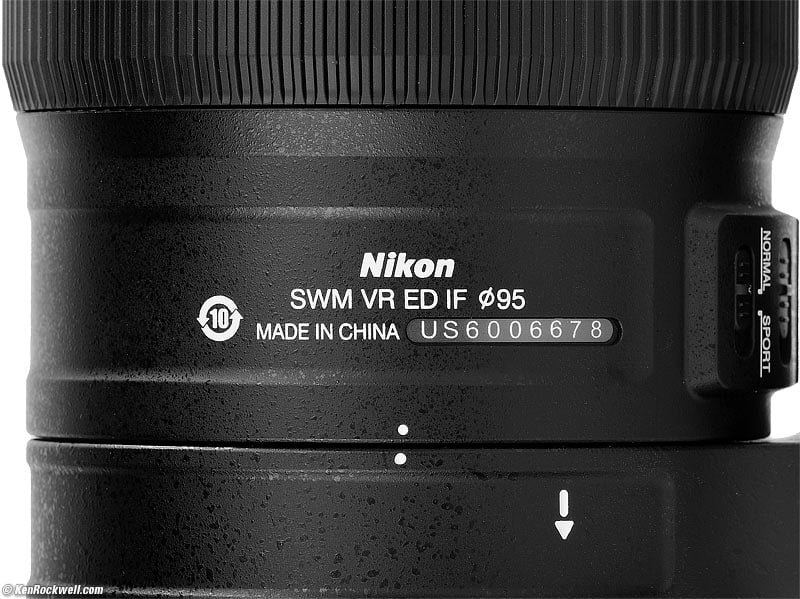
Bottom of Barrel, Nikon 200-500 E.
Nikon calls this the Nikon AF-S NIKKOR 200-500mm f/5.6E ED VR SWM IF ∅95.
AF-S and SWM: Silent Wave Autofocus Motor.
NIKKOR: Nikon's brand name for all their lenses.
E: Electronic diaphragm, just like Canon has been doing since 1987. This means it only works on the newest Nikon cameras.
ED: Magic Extra-low Dispersion glass for reduced secondary chromatic aberration.
VR: Vibration Reduction. Rated 4½ stops improvement, and seems to be at least that good.
IF: Internal focusing; nothing moves externally as focused.
∅95: 95mm filter thread.
Optics
Nikon 200-500mm f/5.6 E VR AFS internal diagram. ED glass.
19 elements in 12 groups.
Three ED glass elements.
Internal focussing.
Pumper zoom; gets longer at 500mm.
It's multicoated, which Nikon calls Nikon Super Integrated Coating.
Close Focus
7.2 feet (2.2 meters) from the image plane, marked.
170º focus ring rotation from ∞ to the close-focus stop.
Maximum Reproduction Ratio
1:4.5 (0.22x).
Diaphragm
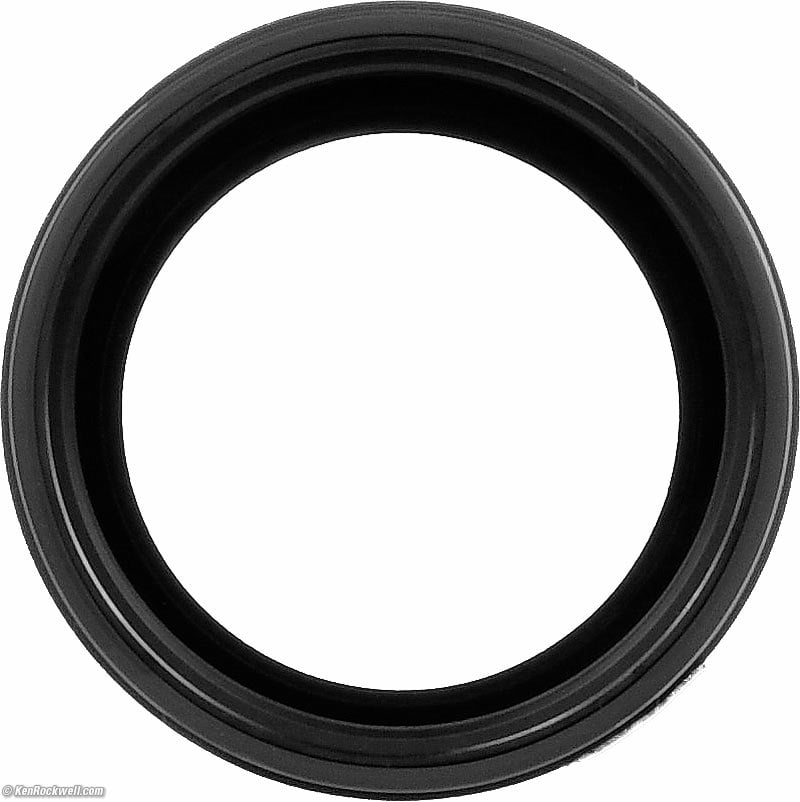
Nikon 200-500mm at 500mm at f/5.6 (diaphragm not seen).
9 rounded blades.
Stops down to f/32.
Electronically controlled for quieter operation, but isn't compatible with cameras made before about 2007.
Vibration Reduction
Rated an astounding 4½ stops.
Coverage
Focal Length
200 ~ 500mm.
When used on a DX camera, it sees angles of view similar to what a 300 ~ 750mm lens sees when used on an FX or 35mm camera.
Angles of View
12.3º ~ 5° on FX digital and 35mm.
8º ~ 3.16° on small-format DX.
Hard Infinity Focus Stop?
No.
You have to let the AF system focus at infinity.
Focus Scale
Yes.
Depth-of-Field Scale
No.
Infra-Red Focus Index
No.
Aperture Ring
No.
Tripod Collar
Included.
Metal.
Removable by sliding off the back of the lens.
Filter Thread
95mm, plastic.
Hood
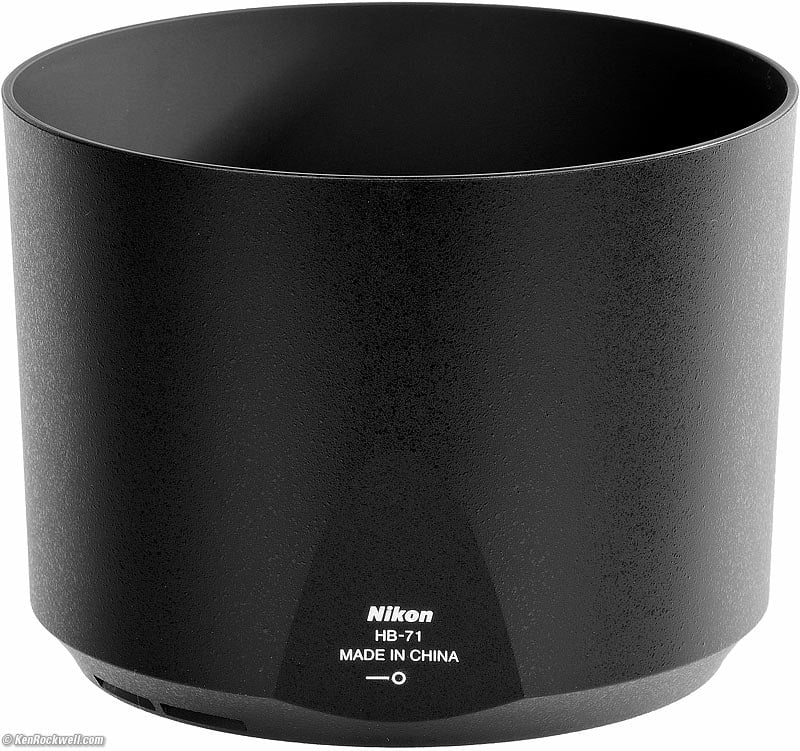
Nikon HB-71 Hood.
HB-71 plastic bayonet hood, included.
5¼" front diameter (133mm) × 4" (102mm) long.
$55 for a replacement.
Case
CL-1434 dust sack, included.
Size
4¼" (108 mm) diameter by 10½" (267.5 mm) extension from flange when set to 200mm.
Gets longer at 500mm.
HB-71 hood is 5¼" diameter (133mm) × 4" (102mm) long.
Weight
Actual Measured Weights
81¼ oz. (2,300g or 5 pounds, 1¼ oz.) with collar.
73¾ oz. (2,090g or 4 pounds, 9¾ oz.) without collar.
Collar alone weighs 7.412 oz. (210.2g).
Rated
81.2 oz. (2,300g or 5 lbs., 1.2 oz.) with tripod collar.
73.8 oz. (2,090g or 4 lbs., 9.8 oz.) without collar.
Included
Lens with removable tripod collar.
HB-71 plastic bayonet hood.
LF-4 rear cap.
CL-1434 dust sack.
Big folded multilingual instruction sheet.
Warranty card.
Quality
Made in China.
Warranty
5 years, USA.
Teleconverters
TC-14E, TC-17E and TC-20E teleconverters, as well as the newer -II and -III versions.
These -E teleconverters allow autofocus, but your camera's autofocus may or may not work since it becomes f/8 or smaller.
As of November 2015, AF only works with the TC-14E on the D4, D4S, Df, D600, D610, D750, D800, D800E, D810, D810A, D7100 and D7200.
There is no autofocus at all with the TC-17E or TC-20E.
Announced
Tuesday, 04 August 2015, 12:01 AM NYC time.
Promised for
17 September 2015.
Shipping Since
People smart enough to have ordered theirs the day it came out got theirs in early October 2015.
As of November 2015, was still backordered.
Price, USA
August 2023
$1,397 new at Adorama, at B&H, at Crutchfield and at Amazon.
About $775 used if you know How to Win at eBay.
May 2023
$1,057 new at Adorama, at B&H, at Crutchfield and at Amazon.
About $875 used if you know How to Win at eBay.
September 2022
$1,397 new at Adorama, at B&H, at Crutchfield and at Amazon.
About $800 used if you know How to Win at eBay.
December 2019
$1,257 new. Adorama had a deal with a free tripod for the same price.
About $900 used if you know How to Win at eBay.
November 2015 ~ December 2018
Introduction, August 2015
Box
Box, Nikon 200-500mm.
Big microcorrugated cardboard box.
Lens in bubble wrap held by folded microcorrugated cardboard inserts.
Oddly the big hood is packed in a separate section on top of the lens, making the top five or six inches of the box (130mm) above the gold band mostly air.
If the hood was mounted on the lens reversed instead of separately, the box could have been much shorter.
Performance
Top Sample Images Intro Compatibility Specifications
Performance Compared Usage Recommendations More
Overall Autofocus Bokeh Distortion Ergonomics
Falloff Filters Focus Breathing Lateral Color Fringes
Macro Mechanics Sharpness Teleconverters
Tripod Collar Vibration Reduction
I got my 200-500 at Adorama. I'd also get it at B&H, at Crutchfield, at Amazon or used at eBay if you know How to Win at eBay.
Overall
The Nikon 200-500mm is a steal at $1,400. It's sharp, has little distortion, focuses well and has terrific vibration reduction.
While it has the same mechanical quality as the 80-400mm VR II AF-S which costs twice as much, this 200-500 has a narrower zoom range, isn't quite as sharp in the full-frame corners at 500mm, focuses more slowly and doesn't focus as close.
In actual use, the pictures are just as good!
Focus
Autofocus
Autofocus is always dead-on and never has to hunt, but it doesn't move as fast as Nikon's much more expensive 80-400mm VR II AF-S (2013-, $2,700), 200-400mm f/4 VR II (2010-, $7,000) or Canon's 100-400mm f/4 L IS II (2014-, $2,200).
Autofocus speed is one thing you lose paying only half the price of the 80-400mm VR II AF-S.
AF speed is only moderate. It's swell for distant wildlife and sports, but not instantaneous like the world's best 100-400mm f/4 L IS II.
Manual Focus
Manual focus is a dream; a fingertip is all it takes to slide the manual focus ring.
It turns 170º from ∞ to the close-focus stop. This is slow at 200mm, and about right for 500mm.
Bokeh
Bokeh, the quality of out-of-focus areas as opposed to the degree of defocus, is neutral. This means backgrounds and foregrounds go soft without distracting, but that they don't completely disappear, either.
Backgrounds get very soft and never distract. This is why long teles lenses like this are a top pro choice for portrait lenses.
Here are full-frame samples shot wide open from headshot distance. Click either for the camera-original file to explore on your computer (portable devices rarely can display the full resolution of these files):
Shot full-frame on D810 at f/5.6 at 1/250 at 200mm. Camera-original file to explore on your computer.
Shot full-frame on D810 at f/5.6 at 1/250 at 500mm. Camera-original file to explore on your computer.
While you're here, notice how the spider webs are exceptionally sharp are in the center where they are in focus. The sides are out of focus; this isn't shot straight-on.
Distortion
The Nikon 200-500 has minor pincushion distortion at all settings and distances. It's usually completely invisible, and most Nikon DSLRs can be set to correct it automatically.
If not, use these values in Photoshop's Lens Distortion tool to remove the distortion. These aren't facts or specifications, they are the results of my research that requires hours of photography and calculations on the resulting data.
On full-frame |
at 2.2m (7') |
at 10m (30') |
at 30m (100') |
200mm |
-1.5 |
-1.5 |
-1.7 |
300mm |
-1.0 |
-1.5 |
-1.7 |
400mm |
-1.5 |
-1.5 |
-1.6 |
500mm |
-1.5 |
-1.5 |
-1.5 |
© 2015 KenRockwell.com. All rights reserved.
Ergonomics
Doesn't fit your screen? It may not fit in your bag, either. This is a big lens. It fits great in my Think Tank Airport Commuter; you'll probably want a backpack for it.
It may not look big by itself, but notice how small is the lens mount in all these photos. Put it on a camera, and you'll see how big it is:
Nikon F3 and 200-500mm f/5.6 at 500mm. bigger.
The good news is that it's not that heavy; it's easy to hand-hold and shoot. The superb vibration reduction makes it trivial to shoot hand-held in any light hand-held.
Most of this lens is its zoom ring, and it's easy to zoom.
Zooming is slow and precise. It's easy to set an exact framing, but takes a big 180º turn to get from one end to the other.
Instant manual-focus override works swell, but you'll have to pull your hand way back to reach the focus ring.
Manual focus is precise (slow) at 200mm, and just about right at 500mm.
Nikkor 200-500mm f/5.6 at 500mm. bigger.
Falloff
Falloff is completely invisible, even with Vignette Control off or shot on film.
I've greatly exaggerated the falloff by shooting a flat gray target and presenting it against a gray background. Even at 500mm at f/5.6, this is invisible in photos:
Nikon 200-500mm VR falloff on Full-Frame, uncorrected
© 2015 KenRockwell.com. All rights reserved.
|
Filters, use with
95mm filters are big, and as with most telephotos, you easily can use a couple of them, even on full-frame, with no fear of vignetting.
There's no need for thin filters.
Focus Breathing
Focus breathing (the image changing size as focused) is mostly of interest to cinematographers who don't want the image changing size ("breathing") as the lens is focused among different subjects.
The image from the 200-500mm gets only slightly larger as focussed more closely; maybe 10% from one end of the focus scale to the other. You won't see this unless you're racking the lens all the way in and out, and then you can't see it unless you're stopped way down so you can see anything at all when it's way out of focus.
Lateral Color Fringes
On a 36MP D810 which corrects these automatically, there are none at 200mm or 330mm.
At 500mm, there can be some yellow-violet lateral color ("purple fringing") if you really push it. It's quite subtle, and not a problem.
Macro
Macro gets close.
Here's what you get on full-frame; DX would be even bigger:
Mondaine A1323034811SBB at close-focus distance at 500mm at f/5.6 on full-frame. camera-original 36MP file to explore on your computer (most portable devices can't show all the pixels in the full resolution file).
Crop from above at 100%. If this is about 6" (15cm) on your screen, printing the complete image at this same high magnification would result in a 50 x 75" (125 x 185 cm) print! camera-original 36MP file to explore on your computer (most portable devices can't show all the pixels in the full resolution file).
This is super-sharp, and it's wide-open at f/5.6!
Mechanics
Rear, Nikon 200-500mm. bigger.
The Nikon 200-500 is made mostly of plastic in China, which is the same as Nikon lenses that cost twice as much!
Front Bumper
Rubbery plastic.
Filter Threads
Plastic.
Hood Mount
Plastic.
Front Barrel
Plastic.
Front Half of Zoom Ring
Rubber-covered plastic.
Rear Half of Zoom Ring
Rubber-covered metal.
Zoom Cams
Seem like plastic.
Mid barrel
Plastic.
Focus Ring
Plastic, rubber covered.
Identity
Plastic plate under plastic focus window with gold-look accents.
Rear Barrel
Plastic.
Tripod Collar
Metal.
Switches
Plastic.
Internals
Seem like all plastic.
Dust seal at mount
Yes.
Mount
Chromed metal.
Markings
Paint.
Serial Number
Sticker glued into a recess on the bottom of the barrel
Date Code
None found.
Noises When Shaken
Very mild clicking.
Made in
China.
Nikon 200-500mm. bigger.
Sharpness
Image sharpness depends more on you than your lens, and lens sharpness doesn't mean much to good photographers. It's the least skilled hobbyists who waste the most time blaming fuzzy pictures on their lenses, while real shooters know that few photos ever use all the sharpness of which their lenses are capable due to subject motion and the fact that real subjects are rarely perfectly flat.
This Nikon 200-500mm is very sharp, but it's difficult to get sharp images with long lenses because of their shallow depth of field, and atmospheric heat shimmer and seeing conditions easily can cloud results. If you're not getting sharp images, you're doing something wrong.
It's always super sharp at all settings 200mm and middle zoom settings, but can get a little softer at the sides of full-frame wide-open at 500mm. Of course it will soften from diffraction at f/16 and smaller.
Even better than sharp, it's sharp even with teleconverters.
Nikon's MTF curves promise spectacular performance:
Nikon 200-500mm MTF at 200mm.
Nikon 200-500mm MTF at 500mm.
Teleconverters
1.4×
The TC-14E III works great. It makes this into a 280-700mm f/8 VR.
The TC-14E II and original TC-14E should work just as well; they're all the same thing.
Even though only 9 sensors of my D810 are rated to work at f/8, it works fine when I select any of the D810 sensors manually — but the AF-Area Auto Select mode seems missing.
AF seems as fast, and it rarely misses or hunts.
Bravo!
Bunny Fencing, 29 October 2015. Nikon D810, Nikon 200-500mm VR at 500mm and Nikon TC-14E III, wide-open at f/8 at 1/1,000 hand-held at Auto ISO 1,100. bigger or camera-original 36MP file to explore on your computer (most portable devices can't show all the pixels in the full resolution file).
Only the bunny fence is in focus, the plants are not.
Eucalyptus, 29 October 2015. Nikon D810, Nikon 200-500mm VR at 500mm and Nikon TC-14E III (making it 700mm) wide-open at f/8 at 1/500 hand-held at Auto ISO 400. bigger or camera-original 36MP file to explore on your computer (most portable devices can't show all the pixels in the full resolution file).
Both images sharp and without falloff on full frame; bravo!
2×
Oddly my D810 will attempt to focus when used with my TC-20E III or original TC-20E, which makes this into a 400-1,000mm f/11.
AF runs back and forth and never stops. AF does not work with the 2× converters, even though the camera tries.
Using a 2× converter is an exercise for the truly afflicted; you'll have to use a tripod and focus via Live View.
Tripod Collar
The metal tripod collar turns freely with no reference clicks.
It locks with a friction lock knob.
You can turn it and pull it off the back of the lens, however big screw heads poking out of the lens are not comfortable for hand-holding.
The tripod collar has a long enough foot that it makes a great handle for holding the lens alone, or a lens and body combination.
Vibration Reduction
Vibration Reduction is excellent. I get perfect results most of the time at 1/15 at 500mm, and I get perfect results about a third of the time at 1/8, hand-held at 500mm!
Perfect means perfect viewed at 100% on-screen. When seen at normal sizes, I can shoot even slower.
I shoot the 200-500mm as I shoot a rifle; you need to know how to hold it steady and pull the trigger slowly and smoothly for the best results.
Here's a typical shot at 1/30 hand-held at 500mm:
Dates, 29 October 2015. Nikon D810, Nikon 200-500mm VR at 500mm, f/11 at 1/30 hand-held at Auto ISO 100. bigger or camera-original 36MP file to explore on your computer (most portable devices can't show all the pixels in the full resolution file).
Great VR makes this lens very, very useful. It means we can shoot it in dim light and never need a tripod unless we're shooting time exposures or star trails.
Compared
Top Sample Images Intro Compatibility Specifications
Performance Compared Usage Recommendations More
(images not to scale) |
|||
| Introduced | 2020 January |
2013 March |
2015 August |
| Speed | f/2.8 |
f/4.5-5.6 |
f/5.6 |
| VR rated | 4 stops |
4 stops |
4½ stops |
| Close-focus | 6.6' 2 m |
5.7' 1.75 m |
7.2' 2.2 m |
| Max. Repro. Ratio | 1:6.25 0.165 × |
1:5.5 0.18 × |
1:4.5 0.22 × |
| Front protective optical plate | none |
none |
none |
| Front filter thread | 112mm |
77mm, plastic |
95mm, plastic |
| Rear Filter Slot | none |
none |
none |
| Outside Diameter | 5.1" 128 mm |
3.8" 95.5 mm |
4¼" 108 mm |
| Length (from flange) | 12" 304 mm |
8" 203mm |
10½" 268 mm |
| MTF, short end (click to enlarge) | 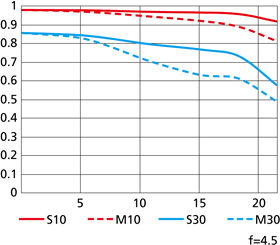 |
||
| MTF, long end (click to enlarge) | 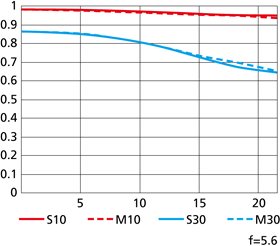 |
||
| Weight, w/collar | 114.6 oz. 3,250 g 7.2 pounds |
55.1 oz. 1,563 g 3.4 pounds |
81¼ oz. 2,300 g 5.1 pounds |
| Price per pound, 01/2020 | $1,320/lb. |
$675/lb. |
$275/lb. |
| Price, 01/2020 | |||
| Price, 09/2022 | |||
| Price, 08/2023 |
This 200-500 is as nice as the 80-400mm, except that it's bigger, heavier and doesn't focus as fast or as close. The 80-400 is a little sharper, but not by much. For half the price, this 200-500mm wins.
I got my 200-500 at Adorama. I'd also get it at B&H, at Crutchfield, at Amazon or used at eBay if you know How to Win at eBay.
I've never understood the point of Nikon's 200-400mm VR II lens, and for normal people, we now have a much better solution, for one-fifth the price.
If we look open class, the Canon 100-400 II is in a class by itself, with much faster focussing than any other tele zoom, excellent VR (IS) performance, much closer focussing and the same build quality as Nikon's $7,000 lenses — for a third the price.
| Anni | 2015- |
2010- |
2013- |
2015- |
2000-2015 |
2006- |
2010- |
2015- |
2013- |
| Zoom Ratio | 2.5:1 |
2:1 |
5:1 |
none |
5:1 |
4.3:1 |
10.7:1 |
4:1 |
4:1 |
| VR/IS? | yes |
yes |
yes |
yes |
yes |
yes |
yes |
yes |
yes |
| Filter | 95mm |
52mm drop-in |
77mm |
77mm |
77mm |
67mm |
77mm |
77mm |
95mm |
| Max Ap. | f/5.6 |
f/4 |
f/4.5-5.6 |
f/4 |
f/4.5-5.6 |
f/4.5-5.6 |
f/3.5-5.6 |
f/4.5-5.6 |
f/5.6-6.3 |
| Zoom | Ring |
Ring |
Ring |
none |
Ring |
Ring |
Ring |
Ring |
Ring |
| Zoom | in-n-out |
Internal |
in-n-out |
none |
in-n-out |
in-n-out |
in-n-out |
in-n-out |
in-n-out |
| Optics | 19/12 3 ED |
24/17 4 ED |
20/12 4 ED 1 Super ED |
16/10 |
17/11 |
17/12 2 ED |
19/14 2 ED 3 ASPH |
21/16 1 Fluorite 1 Super UD |
20/13 |
| Sharp | Very good |
XLNT! |
XLNT! |
XLNT! |
Very good |
Very good |
Very good |
XLNT! |
good |
| AF Speed | meh |
fast |
fast |
meh |
slow |
fast |
fast |
instant |
fast |
| Instnt man. ovride | Yes |
Yes |
Yes |
Yes |
NO |
Yes |
Yes |
Yes |
Yes |
| Close Focus | 7.2' 2.2m |
6.5' 2m |
5.75' 1.75m |
4.6' 1.4m |
7.5' 2.3m |
5' 1.4m |
1.6' 0.5m |
2.6' 0.8m |
8.9' 2.7m |
| Max Repro Ratio | 1:4.5 |
1:3.5 |
1:5.7 |
1:4.2 |
1:4.8 |
1:4 |
1:3.2 |
1:5 |
1:5 |
| Build | meh |
pro |
meh |
meh |
meh |
meh |
meh |
pro |
plastic |
| Made in | China |
Japan |
Japan |
China |
Japan |
Thai |
Thai |
Japan |
China |
| Length | 10.5" 268mm |
14.4" 366mm |
8" 203mm |
5.8" 148mm |
6.7" 170mm |
5.6" 144mm |
4.5" 114mm |
7.6" 193mm |
10.1" 258mm |
| Weight no collar | 73.7 oz. 2,090g |
118 oz. 3,360g |
52.8 oz. 1,480g |
26.6 oz. 754g |
42.7 oz. 1,210g |
26.3 oz. 744g |
28.1 oz. 796g |
49.6 oz. 1,380g |
59.4 oz. 1,687g |
| Price, 03-2013 | n/a |
n/a |
n/a |
||||||
| Price, 06-2013 | n/a |
n/a |
n/a |
||||||
| Price, 10-2015 | |||||||||
| Price, 01-2016 | |||||||||
| Price, 09-2022 | |||||||||
| Price, 08-2023 |
* if you know How to Win at eBay.
Versus Junk Brands
The main reason junk brands are bad buys is because they are short-term buys. After their warranties expire, it's not likely that you'll be able to get them repaired when they break, and very likely that they will not work with whatever new camera you buy ten years from now.
These brands don't make the effort to update years-old lenses to work with new cameras; they step away from the issue like a hot potato and hope you buy a new lens from them instead seven years from now.
When I buy good lenses like Nikon, Canon and LEICA, I know they will last me for decades, always working on my new cameras and repairable if it breaks.
With the junk brands, you get a deal if you only think short term, but when I pay over a thousand dollars for a lens, I expect it to last me for decades.
Sigma and Tamron have poor track records supporting compatibility and repair for lenses over 7 years old, even if the optics can be OK sometimes.
Versus Nikon's AF-S 80-400mm VR
The 80-400mm VR II is a swell consumer lens, priced for professionals.
It's a great lens, but way too expensive for what it is. You've got to be kidding; it's way over $2,000 and made of plastic!
This 200-500 is made just as well, and does pretty much the same thing for half the price.
If price doesn't matter, the 80-400mm goes 2.5 times as wide, goes almost as long, takes normal 77mm filters, focuses closer and much faster and weighs 25% less — but is that enough for double the price?
Versus Nikon's 200-400mm VR
I've never understood the 200-400mm VR. Its zoom range is so narrow that it doesn't really count as a zoom, and it's a $7,000 lens.
It's also much bigger and heavier than this lens, and doesn't focus much closer.
The reason to get the $7,000 version is to look important, or if you plan to abuse it physically and environmentally. It will take more abuse than this 200-500mm.
The 200-400mm is a stop faster, which means it works better with teleconverters (use a 1.4x for a 280-560mm f/5.6), but hold on: I'm going to pay $7,000 and buy a 1.4x converter to make essentially the same thing as this 200-500? I'd rather be able to zoom-out to 200mm than 280mm!
I wouldn't want to hand-hold the 200-400, while the 200-500 is intended for hand-holding.
The 200-400mm is a heavy-duty lens for heavy-duty shooters. People love it, but it's a more specialized lens than this 200-500mm. Even if I gave you a 200-400mm for free, I doubt that you'd want to carry it around.
Versus the Canon 100-400mm L IS II
The Canon 100-400mm L IS II is much better; my favorite tele zoom of all time.
The Canon is a breakthrough professional lens that covers ultra-tele focal lengths, and also replaces all 70-200mm and macro lenses at the same time.
The all-metal Canon 100-400 focuses closer than any pro 70-200mm lens (just 2¾' or 0.84m), so it replaces all 70-200mm lenses as well.
Since the Canon focuses so close and zooms to 400mm at the same time, it's better than most macro lenses since you get the same close picture, but from far enough away to get a better perspective, not pester living subjects and not block your own light.
The Canon 100-400 does nothing for you if you shoot Nikon, but if you're on the fence between Nikon and Canon, I'd get the Canon lens and upgrade to the Canon system instead. Nikon's DX cameras are competitive, while I prefer my full-frame Canons over my FX Nikons.
Usage
Top Sample Images Intro Compatibility Specifications
Performance Compared Usage Recommendations More
I got my 200-500 at Adorama. I'd also get it at B&H, at Crutchfield, at Amazon or used at eBay if you know How to Win at eBay.
Controls, Nikon 200-500mm. bigger.
M/A - M Switch
M/A means autofocus, and also allows instant manual-focus override. Use this setting.
M locks-out autofocus so it's always in manual focus.
Full / ∞-6m Switch
This is a focus limiter.
Leave it in FULL.
The ∞-6m position prevents the lens from autofocusing closer than 6 meters (20 feet). Use this setting only if you're having a problem with the lens attempting to focus on irrelevant close items, or if for some reason the lens is "hunting" from near to far looking for distant subjects.
Vibration Reduction (VR) Switches
ON / OFF
Leave it ON unless you're on a very sturdy tripod, or if you're making exposures longer than a second on any kind of tripod.
Normal / Sport
I leave it in Normal.
Use Sport if you're trying to track objects which change direction unpredictably.
Tripod Collar
This lens is designed for hand-held shooting, so pull off the collar and leave it in the box for resale.
Of course that's just me; do what you want; just don't use this lens for years hand-held with the collar in your way.
Recommendations
Top Sample Images Intro Compatibility Specifications
Performance Compared Usage Recommendations More
I got my 200-500 at Adorama. I'd also get it at B&H, at Crutchfield, at Amazon or used at eBay if you know How to Win at eBay.
This is a great long-range lens, and it's even more fantastic that it's reasonably priced. Get one!
Unlike the new Canon 100-400mm II that focuses so close that it replaces 70-200mm and macro lenses, this Nikon 200-500mm can't zoom wide enough or focus close enough to replace a general-purpose telephoto.
This 200-500 is strictly a long-range lens. It's also big and heavy, so get this 200-500 for airshows, birds, surveillance, intelligence gathering, sunsets and other long-range uses, and you'll still need your regular telephoto along with it.
I use a clear (UV) protective filter instead of a cap (exactly like an iPhone) so I'm always ready to shoot instantly. I only use a cap when I throw this in a bag with other gear without padding — which is never. The UV filter never gets in the way, and never gets lost, either.
I prefer Nikon's 95mm NC filter to protect this lens.
Otherwise I'd use a German brass 95mm B+W 010 UV MRC filter or Japanese aluminum 95mm Hoya EVO UV to protect this lens. Both have special dirt, dust and smudge resistant multicoatings to stay cleaner longer, so it's your choice of brass or aluminum. The 95mm Hoya HMC filter is also superb, but doesn't have the fancy crud-resistant coatings.
All these filters are just as sharp and take the same pictures, the difference is how much abuse they'll take and stay clean and stay in one piece. Since filters last a lifetime or more, there's no reason not to buy the best as it will last you for the next 40 years. Filters aren't throwaways like digital cameras which we replace every few years, like it or not. I'm still using filters I bought back in the 1970s!
This all-content, junk-free website's biggest source of support is when you use those or any of these links to approved sources when you get anything, regardless of the country in which you live. Nikon does not seal its boxes in any way, so never buy at retail or any source not on my personally approved list since you'll have no way of knowing if you're missing accessories, getting a defective, dropped, damaged or used product, a customer return or if the warranty has already been registered to someone else online! The approved sources I use ship from secure, remote automated warehouses where salespeople or other customers never, ever get to touch your lens before you do, and they have the best prices, selection, service and return policies.
Thanks for helping me help you!
Ken Rockwell.
More Information
Top Sample Images Intro Compatibility Specifications
Performance Compared Usage Recommendations More
© Ken Rockwell. All rights reserved. Tous droits réservés. Alle Rechte vorbehalten. Alla rättigheter förbehållna. Toate drepturile rezervate. Ken Rockwell® is a registered trademark.
Help Me Help You top
I support my growing family through this website, as crazy as it might seem.
The biggest help is when you use any of these links when you get anything. It costs you nothing, and is this site's, and thus my family's, biggest source of support. These places always have the best prices and service, which is why I've used them since before this website existed. I recommend them all personally.
If you find this page as helpful as a book you might have had to buy or a workshop you may have had to take, feel free to help me continue helping everyone.
If you've gotten your gear through one of my links or helped otherwise, you're family. It's great people like you who allow me to keep adding to this site full-time. Thanks!
If you haven't helped yet, please do, and consider helping me with a gift of $5.00.
As this page is copyrighted and formally registered, it is unlawful to make copies, especially in the form of printouts for personal use. If you wish to make a printout for personal use, you are granted one-time permission only if you PayPal me $5.00 per printout or part thereof. Thank you!
Thanks for reading!
Ken.
